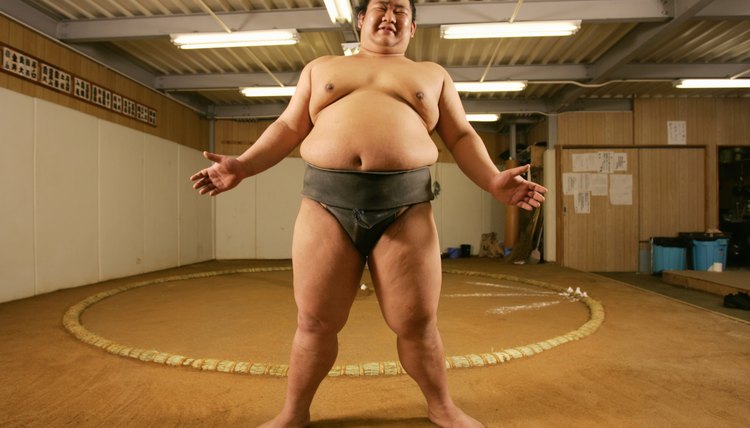Sumo Wrestler Training

Despite their obese appearance, Japanese sumo wrestlers must endure vigorous physical training before becoming official rikishis, the Japanese term for sumo wrestler. An aspiring rikishi battles his way from the lowest wrestling division, called jonokuchi, to the top two divisions of makuuchi and juryohis before receiving a salary and the esteemed title of sekitori, or professional wrestler. The life of a lower-division sumo wrestler is generally less glamorous, consisting of serving the sekitori, daily chores and a small subsistence allowance.
The Stable
All professional sumo wrestlers began their careers as youngsters in a communal environment known as a stable. Stables contain all of the people who are involved in the production of sumo wrestling, including hairdressers, referees and retired sumo wrestlers who conduct training sessions. These communes are run by a stable master and his wife -- an oyakata and okamisan -- with the goal being that of preserving and teaching the various disciplines and traditions of sumo wrestling.
Leg Strengthening
Aside from the on-the-job training that lower-ranking wrestlers undertake every time they walk unto the sandy dohyo, or ring, the wrestlers partake in physical training at the stable as well. Typically, sumo training begins at 5:00 a.m. with shiko -- leg stomping exercises -- to teach wrestlers how to maximize their balance and core strength to overcome opponents. Traditional shiko consists of lifting one leg high into the air and then slamming it back to the ground.
Balance & Flexibility
A sumo wrestling match concludes when one of the wrestlers is either knocked out of the ring or hits the sand with any part of his body other than his feet. Sumo wrestlers in training partake in hand and foot shuffling and all-over muscle stretching exercises -- called teppo and matawari-- for this reason. The Japan Sumo Association says these exercises teach wrestlers how to use the force of gravity to maximize their sense of balance and physically overtake their opponents.
Eating Habits
Sumo wrestlers maintain their infamously large physique with the help of chanko, a high-protein, high-starch, high-calorie diet which wrestlers consume twice daily to keep their metabolism low. According to Web-Japan.org, at around 11:00 a.m. and later at 6:00 p.m. the younger wrestlers serve the chanko which generally consists of stews, sashimi, deep-fried food and hamburger steaks. Taking long naps after meals is viewed as a training tactic that helps wrestlers achieve a bigger physical presence.
References
Writer Bio
Based near America's "Gateway to the West," Li St. Michael has been writing professionally since 2005. Her culturally minded articles have appeared on various websites. St. Michael holds a Bachelor of Science in writing from Drury University and is set to receive a Masters degree in international relations in 2011.
